SATURDAY
AUGUST 16 - 2014
BROOK
MEADOW
Oak leaf infections
I had a look
at the three Jubilee Oak saplings that were planted on
the on the Seagull Lane patch in 2012. They all seem
to be growing well, though some leaves have a variety
of things growing on them. Spangle galls were
the most common; these are caused by the wasp
Neuroterus quercusbaccarum. Some leaves
had a whitish fungal growth shown on the leaf
on the right in the photo, which I have not
identified.
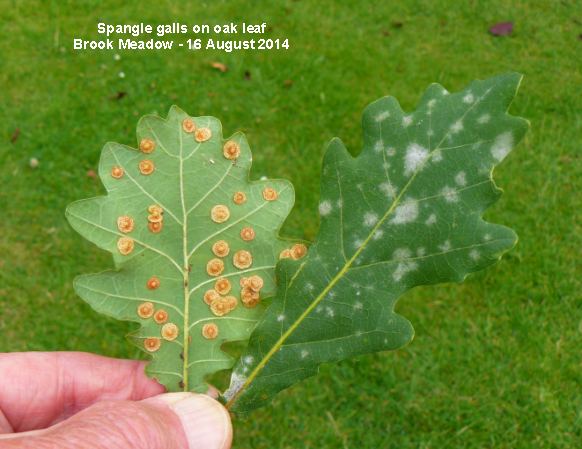
Other oak leaves had
damage in which the inside of the leaf had apparently
been eaten leaving only a skeleton of cells. This
reminded me of leaf miner grub damage, but there was
no sign of the culprit.
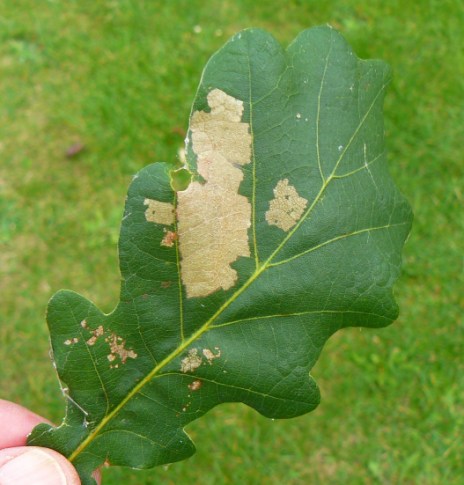
I also had a look at
the medium sized Oaks on the east side of the north
meadow where I found Knopper galls and marble galls.
Knopper galls are hard irregular distortions of
an acorn caused by the wasp Andricus
quercuscalicis.
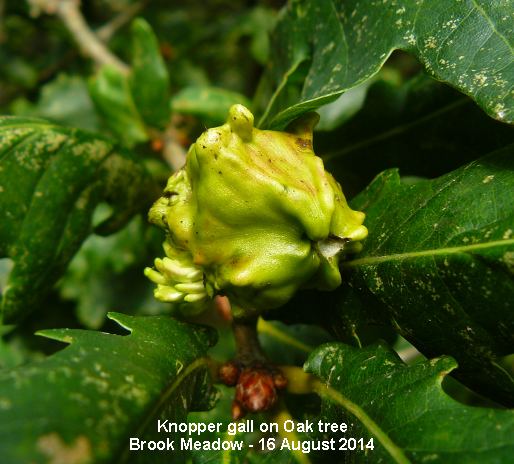
Marble galls
are round, smooth and hard growths caused by the
wasp Andricus kollari. Note, these are
not the same as oak apple galls which are spongy and
irregular and contain many insects.
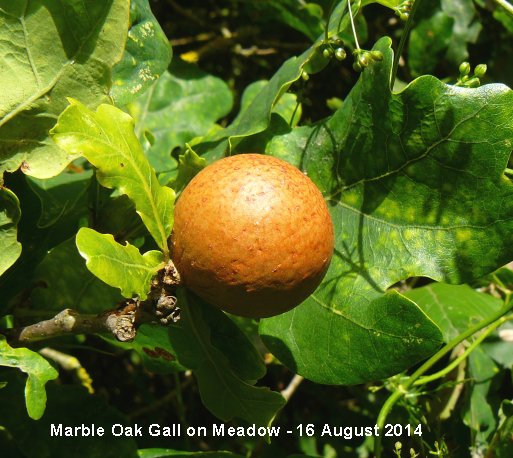
Common
Orache?
I noticed some goosefoot plants by the south gate.
They don't look like the usual Spear-leaved Orache
which is fairly common the meadow. However, the
triangular shape of mid-stem leaves with basal lobes
pointing forward and narrowing into the stalk suggests
Common Orache. If confirmed this would be a new plant
for the Brook Meadow list!
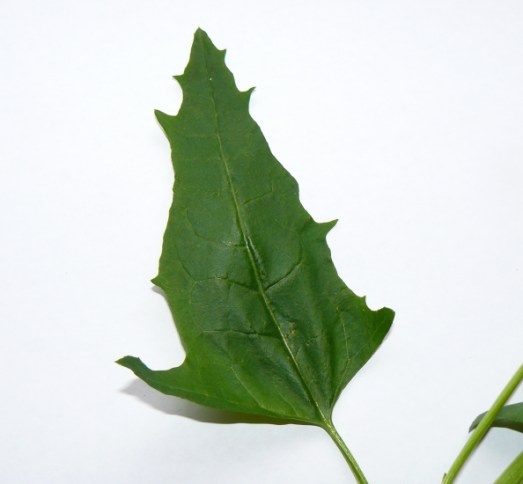
Insects
on Wild Angelica
Wild Angelica
plants are looking good on the Lumley area with their
flower heads attracting lots of insects. I spotted
this bright yellow and black wasp-like insect feeding
on one of the flower heads. My very tentative
identification is Ceramius lusitanicus -
(Chinery p. 240).
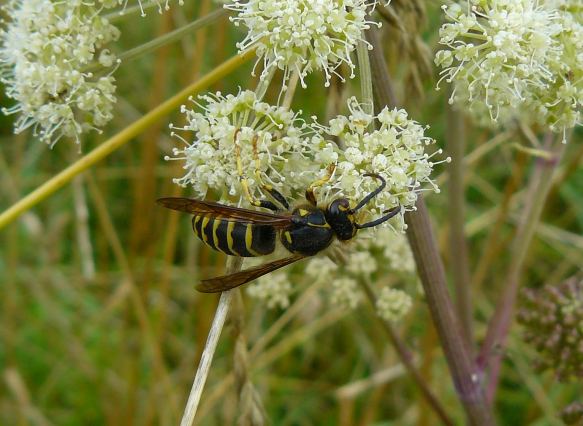
Kingfisher
David Minns
was sitting on the seat overlooking the main meadow
yesterday when a bird flying fast across the meadow
from east to west caught his eye. As it passed David
saw its bright blue rump - yes it was a Kingfisher.
This was only the second time he'd see one here. This
may have been one of the juveniles dispersing from
breeding sites further up the Ems Valley.
Old
Winchester Hill
Heather Mills
reported on this morning's walk by the Havant Wildlife
Group.
See report at . . .
http://familyfellows.com/hwg-walk-reports-2014.htm
FRIDAY
AUGUST 15 - 2014
Brook
Meadow
I had a quiet
stroll through the meadow this morning. Had a look
along the river path for dragonflies, but only spotted
a Common Darter. There was a Moorhen family on the
river south of the S-bend with mum feeding two tiny
chicks, clucking constantly to keep them in touch.
Good to see. We usually have three Moorhen pairs on
the river. This is a late brood.
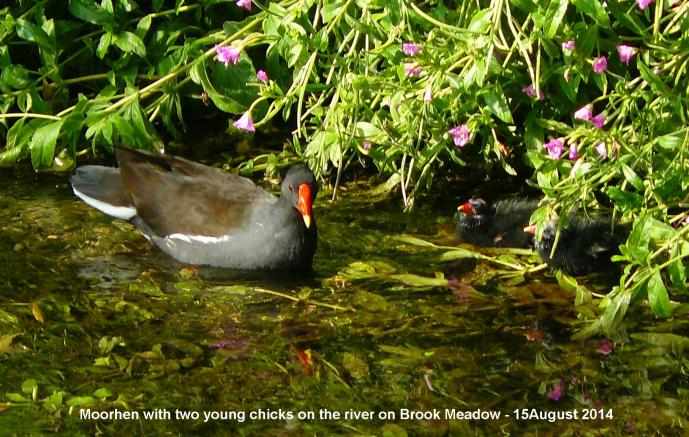
Hoary Ragwort is
always one of the latest plants to flower; the small
yellow flowers are now starting to show on the orchid
area. The Strawberry Clover fruits on the east
side of the Lumley area are ripening fast and look
almost good enough to eat! Not seriously.
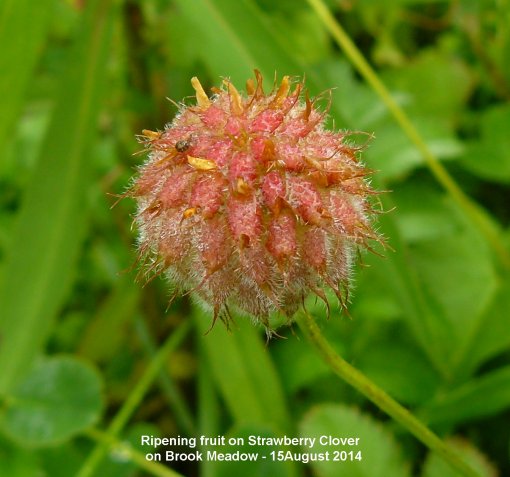
Pam Phillips spotted a
young Water Vole behind the new sign north of
the bulrushes this morning at 7.30am. It was munching
away at vegetation near the west bank. It is the first
one she has seen for months.
Pam also saw 2 rabbits hopping along the path
near the Rowans the other morning. Rabbits are unusual
on Brook Meadow.
Emsworth
Harbour
I had a quick
look at the harbour this morning. I counted 32
Black-tailed Godwits, 8 in the upper channel and
24 on the far side of the main channel. I could not
make out any colour-rings, though there could well
have been some. Other birds included small numbers of
Redshank, Turnstone, Curlew and a single Dunlin with
the godwits. Dunlin is a common breeder in Iceland and
this bird probably came down with the Black-tailed
Godwits as did the Turnstone.
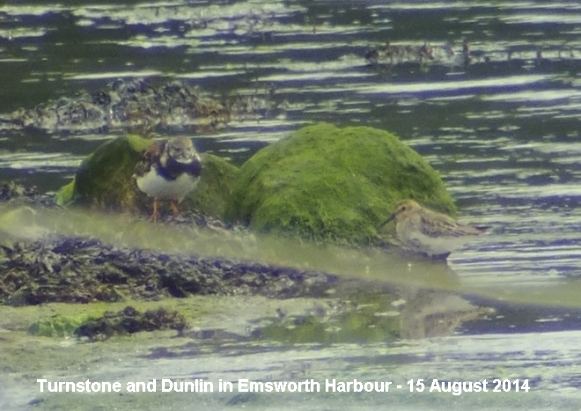
Wax
Moth larvae in Bumblebee nest!
I am very
grateful to Chris Oakley for pointing out that the
yellow grubs I found in the Bumblebee nest yesterday
were not Bumblebee larvae, but larvae of the dreaded
wax moth. As an ex-beekeeper Chris says they are
capable of destroying an entire hive in just a few
months. The larvae feed on both wax and honey thereby
contaminating it. There is no sure way of getting rid
of them them, so the infected combs have to be removed
and burned. They are bad news for honey-bees and for
wild ones as well, the only difference being, that the
wild bees make new nests each season.
I checked on Google and the images of the wax moth
larva are identical to those yellow grubs I found in
the nest. The wax moth larvae tunnel through the nest,
leaving a tough silk screen to hide behind and to feed
in relative safety from the bumblebees, which have
difficulty penetrating it. This is clearly the wooly
substance that was prominent in the nest that I
dismantled. I hope the new Bumblebee queens managed to
disperse before any serious damage was done.
A good account of the havoc produced by the wax moth
larvae in a Bumblebee nest can be seen at . . .
http://nurturing-nature.co.uk/wildlife-garden-videos/bumblebees-and-wax-moths-the-silent-but-deadly-killers-must-see-video-2/
This site also has photos of the inside of a Bumblebee
nest that has been invaded by this moth, which are
just like those I took yesterday. The scientific name
of the moth is Aphomia sociella and it
is a parasite of bees and wasps. It is a small moth
and enters the nest undetected, at night when nest
activity is at it lowest. This is the only moth that
occurs in bumblebee nests and is not to be confused
with the lesser wax moth (Achroia
grisella) which is attracted to honey bees.
Arundel
Wetlands Centre
Malcolm
Phillips and Jenny had a good day at the Arundel
Wetlands Centre. In one of the hides they a found a
nesting family of Swallows.
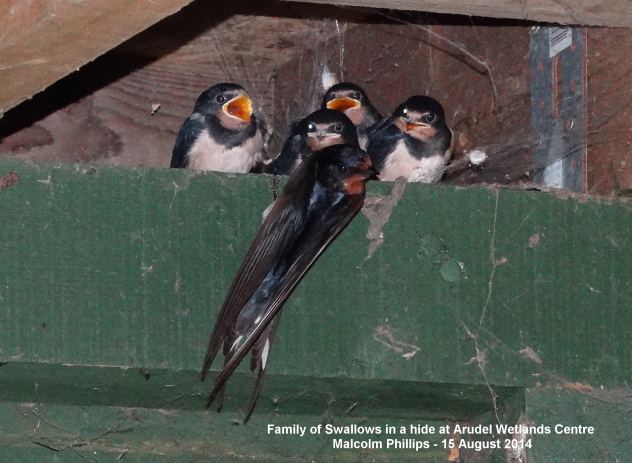
They also went on the
boat trip and got the regulation sighting of a
Water Vole.
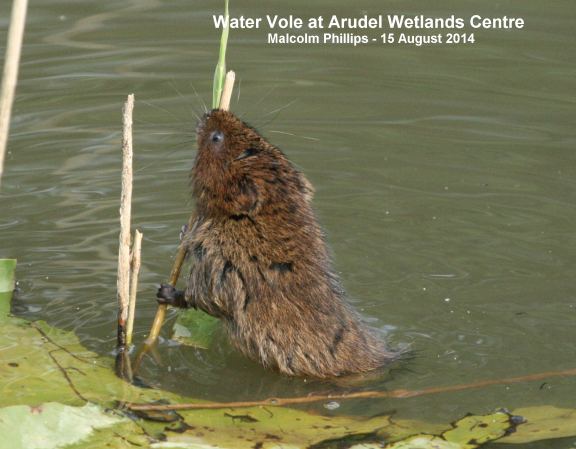
THURSDAY
AUGUST 14 - 2014
Emsworth
Harbour
This morning I
positioned myself on the marina seawall at 11am (about
4 hours to high water) and watched the tide come in
for the next hour. The godwits were feeding in two
groups with 17 in the upper channel and another 15 in
the lower channel off the Thorney shore, making a
total of 32 Black-tailed Godwits in all. Among
the former group were two colour-ringed birds: G+WR
which I first saw yesterday and O+OL.
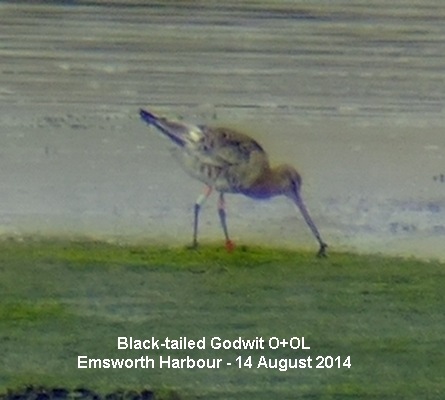
O+OL - has been
a fairly regular wintering bird in Emsworth Harbour
since it was ringed as a first summer male on
26-Jun-05 on Thorney Island. It has also been seen in
several other local sites, including Fishbourne,
Bosham, Pagham Harbour and Pulborough Brooks. However,
I had no record of it in Emsworth at all last winter.
This was my first sighting this winter season.
There were several Greenshank on the mudflats,
but I picked up just two of the colour-rings, both
regulars, GN+YY and RG+BY.
Tree
Bumblebee nest
I had a phone
call from an old friend Colin Harrington to say he had
a Bumblebee nest in a bird box in his garden which he
thought I might be interested in. I certainly was and
went over to his house at Denvilles to take a look.
The bees had gone and Colin had removed the bird box
which was a multi-hole design nesting box. The front
has been removed to show the nest.
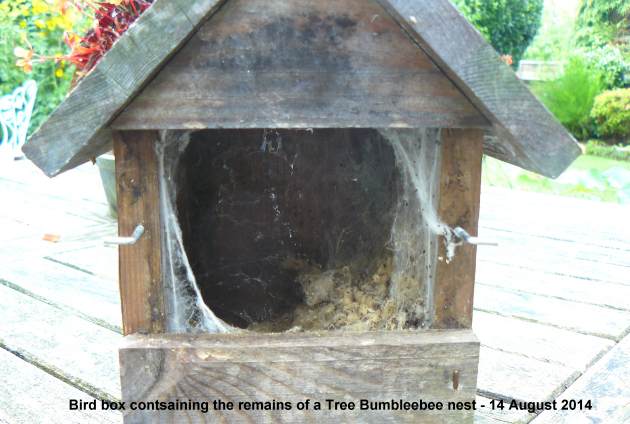
Colin was sure they
were Tree Bumblebees (Bombus hypnorum),
which have a ginger thorax with a dark abdomen and
white tail. They have only been seen in Southern
England for the last 13 years, but are becoming more
common. They typically nest in old burrows, on the
ground, or in elevated places like trees or bird
boxes, as in Colin's case. Last year my neighbour had
a nest under the eaves in his roof. Bumblebee expert
Bryan Pinchen stressed that Bumblebee nests should not
be disturbed as they are not harmful and do not cause
any damage. Tree Bumblebees complete their cycle in
early summer and then leave the nest.
When I got home I
proceeded to extract the Bumblebee nest which was not
an easy job as it was fairly solid structure and glued
securely to the walls of the nest box. The cells of
the nest were clearly visible, woven together with a
wool-like material. They looked rather messy and
untidy in comparison with the neatly packed hexagonal
cells of a Honey Bee nest.
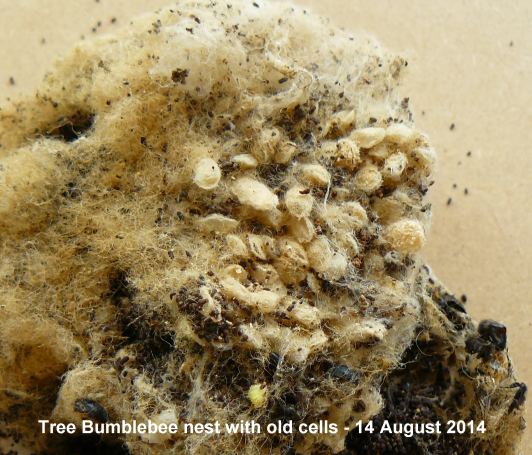
I disturbed a number
of yellow grubs, which I assume were Bumblebee larvae
which got left in the nest when the Queen and the rest
of the bees dispersed. They were still very much
alive. This one was crawling away.
CORRECTION
- The grubs were not the larvae of the Bumblebees but
of the dreaded Wax
Moth larvae. Let's
hope the bees escaped before any serious damage was
done. See tomorrow's blog entry for more information.
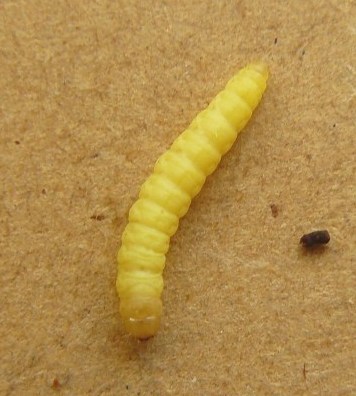
Finally I spotted one
small bee (quite dead) which had also been left behind
in the nest.
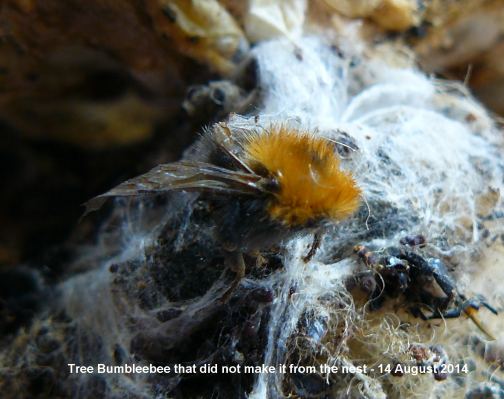
Migrant
Hawkers
Malcolm
Phillips got a cracking photo of a male Migrant Hawker
on Brook Meadow this morning. He said there were three
on one plant near the S-bend in the river!
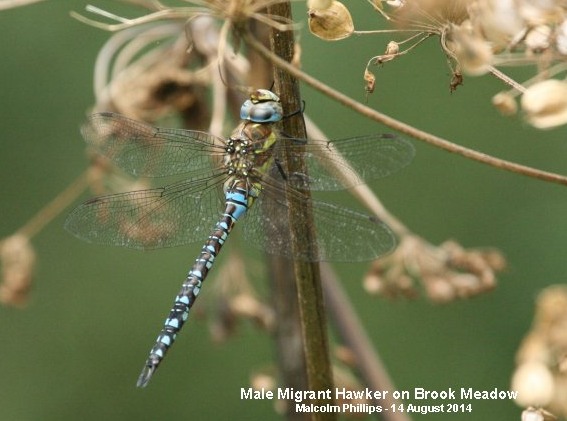
We often get Migrant
Hawkers on the meadow in late summer. In the 1940s
Migrant Hawkers were uncommon migrants from Southern
Europe, but they have gradually extended their range
and now breed widely in the south and east of England.
There are still regular migrations from the Continent
increasing the population in late summer; these could
be the ones that we tend to see on Brook Meadow at
this time of the year.
Warblington
shore
Peter
Milinets-Raby went along the Warblington shore from
10:05am to Noon. Species of note were as follows:
Off Conigar Point: 8 Ringed Plover, 2 Lapwing, 6
Dunlin, 2 Lesser Black-backed Gulls, 3 Greenshank (one
with rings RW - /BYtag -), 1 Common Tern, 1 Little
Tern.
Tamarisk Hedge by the point: 3+ Chiffchaff, 4+ Willow
Warbler, 1 Reed Warbler, 2 Long-tailed Tit, 3 Stock
Dove, 1 Wheatear on the stone wall very briefly
(Peter's first).
Off Pook Lane: 11 Grey Plover, 12 Dunlin, 1 winter
Black-tailed Godwit, 1 winter Bar-tailed Godwit, 11
Greenshank (only ring close enough was G - R/GRtag -),
7 Common Gulls, 108+ Redshank.
Langstone Mill Pond: 62 Little Egrets loitering in the
trees with 3 Grey Herons.
Malcolm's
'Chiffchaff'
Peter thinks
Malcolm Phillips's bird that he took yesterday on
Peter Pond was in fact a Willow Warbler and not as I
thought a Chiffchaff. He says, "greenish tone, pale
yellow supercilium and pale legs and feet; the primary
extension is virtually the same length as the tertials
- all this is indicative of a Willow Warbler. In
Chiffchaff the primary extension is half the length of
the tertials." The pale legs also supports Willow
Warbler. I'm not going to argue with Peter's greater
experience, but it just goes to show how difficult
distinguishing Chiffchaff and Willow Warbler is until
they actually sing!
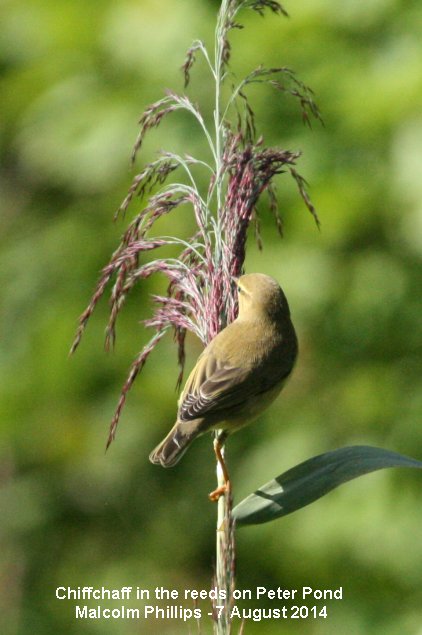
WEDNESDAY
AUGUST 13 - 2014
Emsworth
Harbour
I positioned
myself on the marina seawall at 10am and waited for an
hour or so for the incoming tide to push some
Black-tailed Godwits my way. But annoyingly that did
not happen. The conditions were fairly good, despite
the stiff breeze blowing into my face, but the main
flock of Godwits that I saw here on Aug 9 did not turn
up. About 20 or so were feeding in amongst the boats
on the far side side of the channel.
However, I did find my first colour-ringed
Black-tailed Godwit of the year G+WR. This is an
'old friend' over many years in Emsworth and it was
good to see it back 'home'. G+WR has been a regular
wintering bird in Emsworth Harbour in the six winter
seasons since it was ringed by Pete Potts and his team
at Farlington Marshes on 10-Sep-08 as an adult male.
Overall, it was my 100th sighting of the bird in
Emsworth!
There were also
three colour-ringed Greenshanks feeding in the
pools in the harbour.
GN+YY - My 2nd sighting this season - first on
09-Aug-14.
G+BY tag - This was my first sighting of this
bird.
RG+BY tag - My 6th sighting in Emsworth Harbour since
04-Apr-13.
Greenshanks
RG+BY and G+BY were feeding together for much of the
time
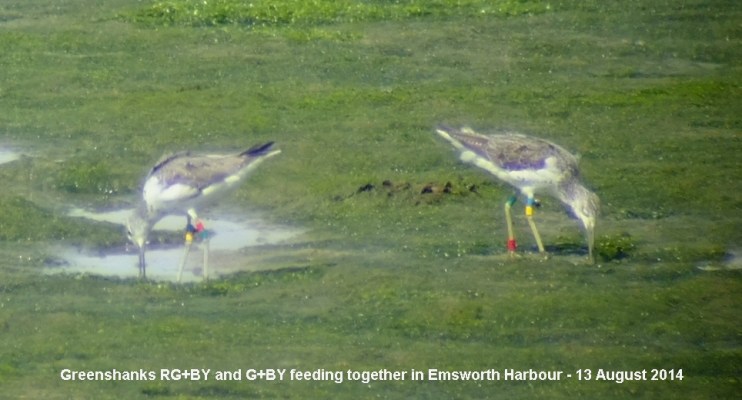
Other birds seen in
the harbour: Little Egrets, Redshank, Turnstone and
Curlew, plus the usual collection of gulls.
Jeff
Flemming's photos
Jeff Fleming
sent me his photos on a CD of the Water Voles he saw
on Aug 7 on Brook Meadow. In fact, he had two
sightings, one in section B by the gasholder and the
other in Section C south of the S-bend. Here is Jeff's
excellent photo of the former vole feeding on river
weed.
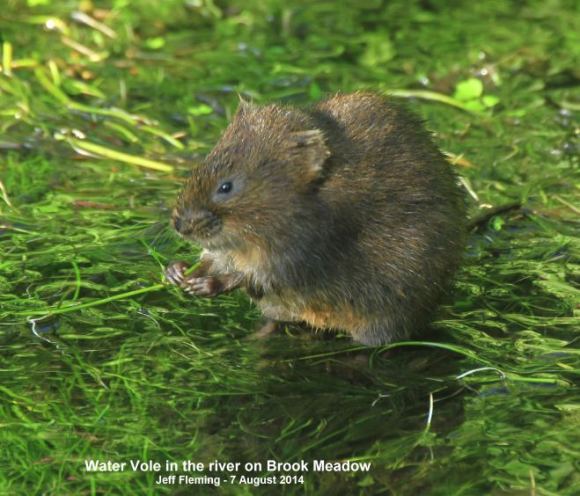
Jeff also got some
interesting photos of Common Darters in flight. He
explained that the shutter speed on his camera was not
fast enought to freeze the wings in flight, but the
suspended body shows up really well.
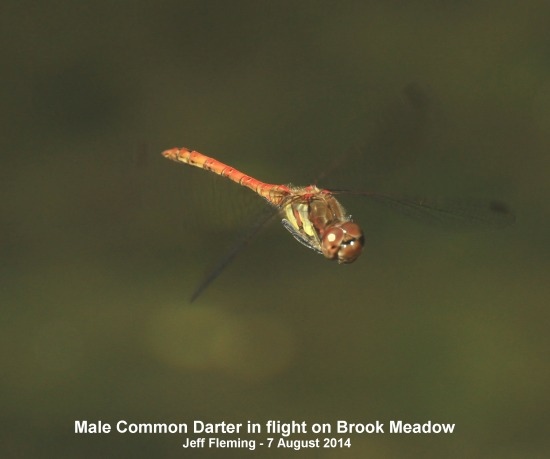
Chiffchaff
Malcolm
Phillips went down to Peter Pond this morning with his
camera and got this rather nice photo of a Chiffchaff
in the reeds. The photo shows well the short primary
projection of the wing feathers, which distinguishes
it from a Willow Warbler. Chiffchaffs will be here for
some while yet, in fact, some will probably overwinter
in our area.

Sorry, the date of this photo should be 13 August
2014
CORRECTION
- This bird was
probably a Willow Warbler. See next day's blog entry.
Bee
with pollen
Charlie
Annalls was on Hilsea Lines where she got this amazing
photo of a Honeybee carrying huge pollen baskets on
its legs.
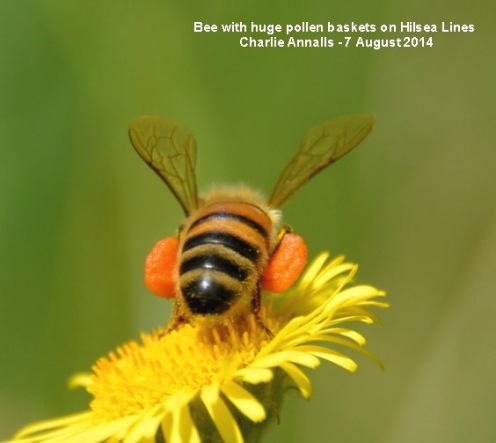
Sorry, the date of this photo should be 13 August
2014
TUESDAY
AUGUST 12 - 2014
Greater
and Lesser Burdock
Peter
Milinets-Raby decided to take a look at the Greater
Burdock along the southern edge of Emsworth Recreation
Ground and took several close-up photos of the flowers
to compare them with the Lesser Burdock flowers at
Conigar Point. I found the differences difficult to
see. In fact, the key difference between the two
plants is not so much the flowers themselves, but the
way they are arranged. The flowers of Greater Burdock
tend to be arranged in a flat-topped cluster with
relatively long stalks (up to 10cm). The flowers of
Lesser Burdock are spread out down the stem and the
stalks are shorter. Here is a photo of the Greater
Burdock I took last year which shows this.
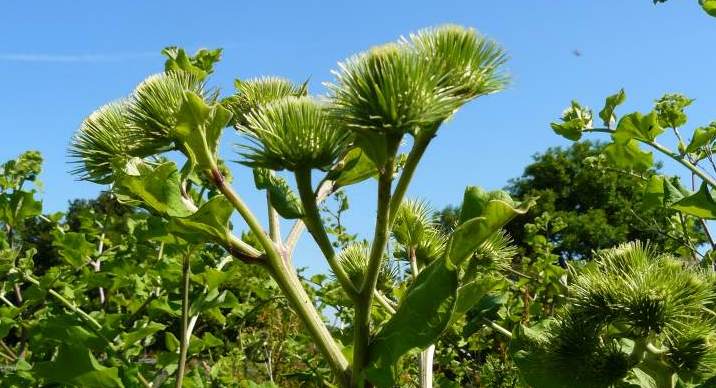
But the most reliable
way of distinguishing between the two plants is to cut
through a basal leaf stalk; the stalk is solid in
Greater Burdock and hollow in Lesser Burdock. There is
no doubt that the plants on the Emsworth Recreation
Ground are Greater Burdock as I have checked the
stalks and they are definitely solid. Martin Rand
confirmed the identification.
Amphibians
galore
Mark
Ringwood's garden in Lumley Terrace backs onto Brook
Meadow and has recently seen a 'huge' upsurge in the
numbers of Frogs, Newts and Toads. He wants to "raise
their existence as they seem to be unsung heroes".
Good for you, Mark.
Hampshire
Farm
Chris Oakley
took a walk over to the Hampshire Farm pond this
afternoon and despite the recent rain the water level
remains the same. He says, "There were traces of water
from two of the drains and the main inlet but nothing
like what you might have expected from the downpours
we have had. I assume that the ground is soaking it
up.
It was lovely and warm despite the wind. Not so many
birds today. Only five House Martins and three
Swallows. One pleasing sight was the flock of perhaps
fifty House Sparrows but - I also found the remains of
two Black-headed Gulls.
The Common Blue butterflies are still around as are
the Blue Damselflies. There were several Broad-bodied
Chasers and a couple of Emperor Dragonflies.
Some of the summer flowers are blooming again
including Corn-cockle, Corn Marigold and the Red
Bartsia. Fleabane is colouring the meadow a golden
yellow at the top end of the site which is under
clouds of Thistle down caught up in the wind. The
blackberries are variable in taste some beautifully
sweet and others that make your teeth
itch."
MONDAY
AUGUST 11 - 2014
Arundel
Wetlands Centre
Jean and I
celebrated our 52nd wedding anniversary with a visit
to the Arundel Wetlands Centre. And very good it was
too, such a big improvement from when we were last
here a few years ago when the huge reconstruction of
the reserve was taking place. Most of the captive
birds were still there, e.g., Nene, Ruddy Shelduck,
Whistling Ducks, Black-headed Swans, etc, though fewer
in number than I recall from years ago. However, there
were plenty of wild bird sightings on the boards,
including Sand Martins feeding over the water, a pair
of Kingfisher, a Common Sandpiper, a Red Kite and
Kestrel.
But the big change we noticed was the emphasis there
is now on non-bird wildlife, e.g., Water Voles, wild
flowers and insects. For example, there was a superb
'Meadow Maze' where paths had been cut through a small
meadow which was ablaze with wild flowers attracting
lots of insects.
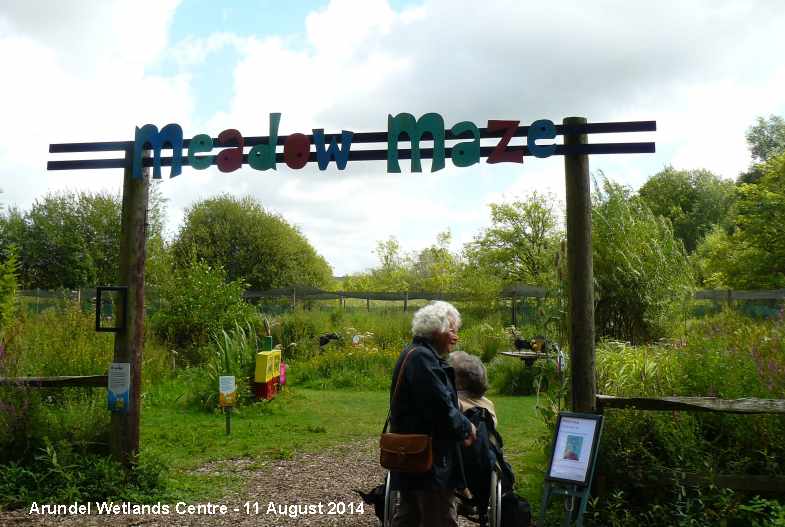
There was such a great
atmosphere on the reserve with lots of families with
young children. There is plenty to attract them. There
were also helpful human reserve guides and informative
notices.
Among the plants in flower along the paths were Hemp
Agrimony, Purple Loosestrife, Wild Angelica, Water
Mint, Common Fleabane, Common Ragwort, Teasel and
masses of Tansy - the first I have seen this year.
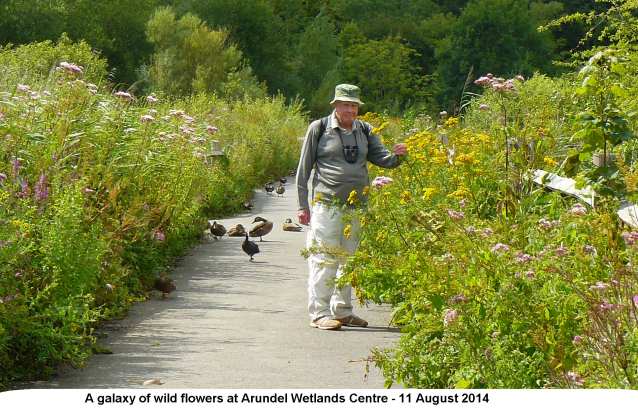
We stopped for lunch,
then went on the boat safari for the first time ever.
It was an interesting experience to weave in and out
of the reedbeds on a silent boat. We were lucky to get
views of two Water Voles, one adult and one juvenile,
though both were partly hidden in the reeds as we
passed by. Here is my best shot of the adult. Don't
laugh, Malcolm!
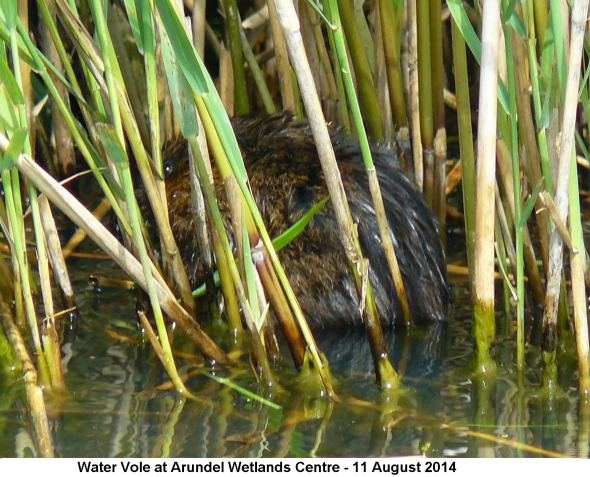
While walking round
the reserve we came across an Elephant Hawkmoth
larva slowly crawling across a gravel path in the
hot sun. It was attracting the interest of some Nene
geese nearby so I moved it across to the grass verge
where it would be safer. I noticed it retracted its
snout when I tried to pick it up, not an easy job!
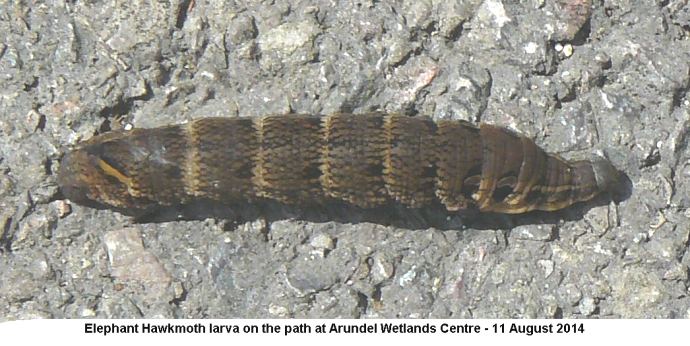
The Arundel Wetlands
Centre has a revamped web site containing an
interesting video wildlife diary from reserve manager
Paul Stevens, including sightings of Lesser Centaury
and Brookweed. http://www.wwt.org.uk/wetland-centres/arundel/wildlife/wildlife-weekly/
SATURDAY
AUGUST 9 - 2014
Emsworth
Harbour
15:00 - I
timed my visit to the harbour for about 4 hours after
high water which is usually good for Black-tailed
Godwits. This was my first visit of the new season and
I was looking forward to seeing a good flock. ! The
tide was right and conditions were good apart from a
strong wind blowing straight into my face.
And there they were, just as predicted feeding in a
loose flock on the mudflats off theWickor Bank. I
counted 71 Black-tailed Godwits, including many
in various stages of moulting from their summer
plumage.
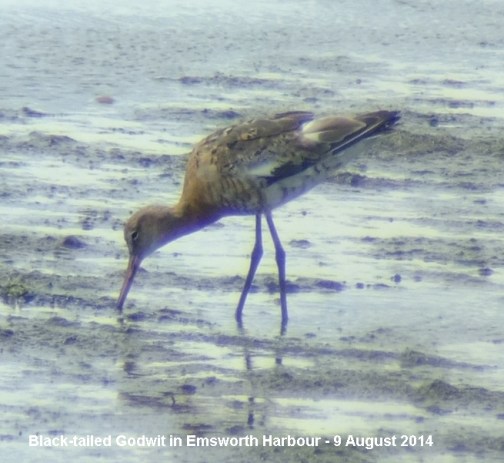
I looked for any
juveniles but did not see any, though it would be a
bit early for youngsters to arrive from their breeding
grounds in Iceland. These early birds will probably be
non-breeders or failed breeders. I went through the
flock several times for colour-ringed birds, but again
did not see any. However, it was so good to get back
to birdwatching in my favourite habitat and to see
good numbers of my favourite wader.
There was a colour-ringed Greenshank on the
mudflats with the combination GN+YY - I think the
black ring could have been tagged. I have no previous
record of this bird so will pass it onto Anne de
Potier who is now keeping the colour-ringed Greenshank
records.
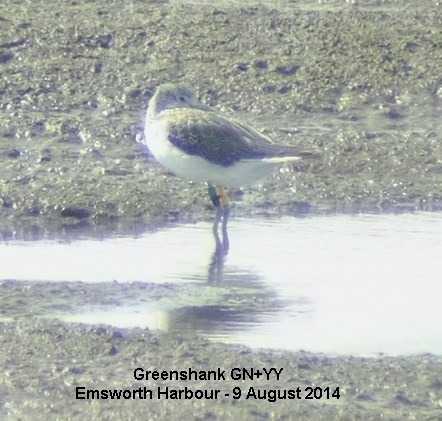
There was not much
else in the harbour apart from a few Redshank, a
Curlew and the usual gulls.
Havant
Water Voles
Malcolm
Phillips went over to Havant to look at the Water
Voles on the Langbrook Stream. He and Jenny stood for
about an hour and a half watching them feeding, they
seemed to be everywhere and they counted 8 altogether.
Here is a couple of the photos Malcolm sent. Three of
the photos showed a vole with a damaged left eye which
might help to identify it in future.
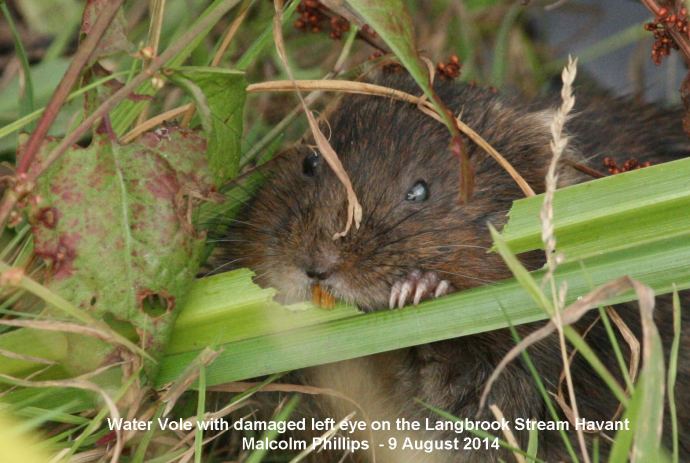
Here is another of
Malcolm's photos of a Water Vole with a normal left
eye.
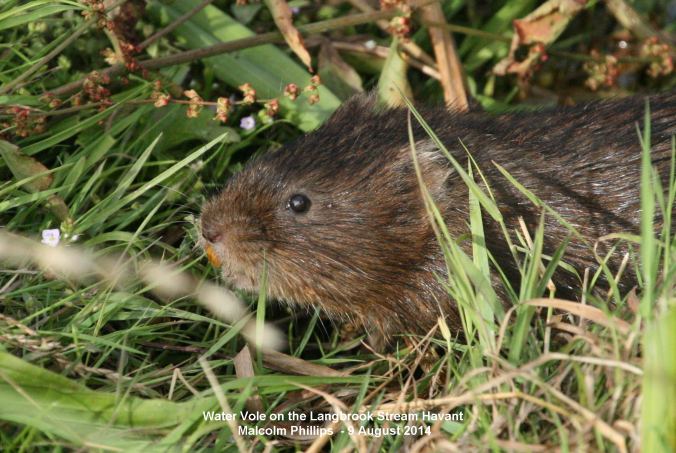
Warblington
shore
Peter
Milinets-Raby did his regular jaunt along the
Warblington shore this morning from 6:50am to 8:45am.
It was cold and windy and he needed gloves for the
first time. Autumn is certainly coming. The highlights
were as follows:
Ibis Field: 70+ Goldfinch in cemetery extension,
Moorhen.
Hedgerow behind Conigar Point: 3 Chiffchaff, 2 Reed
Warbler (one seen very well with bright yellow feet!),
4 Long-tailed Tits, Lesser Whitethroat, 8+ Willow
Warbler (nice photo of one). Tamarisk Hedge: 1+
Chiffchaff calling
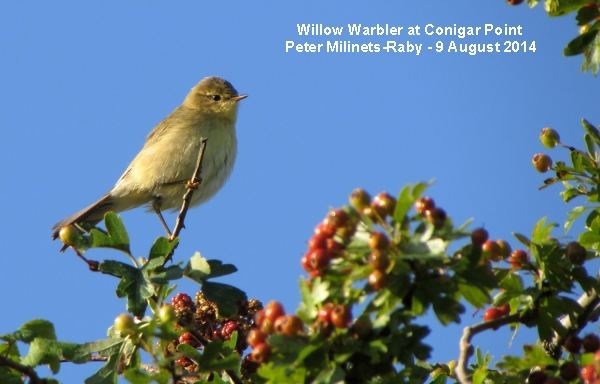
Conigar Point:
(surprisingly quiet). 21 Dunlin, 2 Grey Plover, 1
winter Black-tailed Godwit, 1 Common Gull, 2 Lesser
Black-backed Gull, 2 Mute Swan, 2 Lapwing, 10 Swallows
over heading south.
Pook Lane: 1 Whimbrel, 48 Dunlin, Common Tern, Sand
Martin, 15 Greenshank (note ring colours - two birds
with same combination, but one colour below the knee
on the left leg. G//R+GO, G//R+YN, R//G+YYtag,
RG+YYtag, G//R+BBtag, N//R+RY.
Wheatear
in garden
This evening
at 5:50pm a Wheatear was a pleasant addition to
Peter's garden list. It spent the next hour and a half
enjoying the garden of a house three gardens down. He
was lucky to grab the photo of it on the roof of the
shed - the same one the 33 House Sparrows like to sit
on in the morning sunshine!
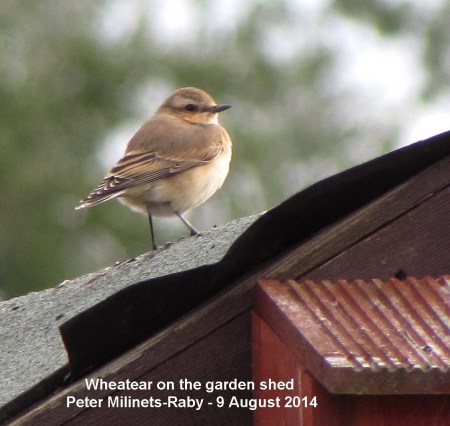
FRIDAY
AUGUST 8 - 2014
Warblington
shore
Peter
Milinets-Raby was up early this morning to have a walk
along the Warblington shore (6:50am to 8:40am. A quick
incoming tide meant he never reached Pook Lane before
the waders flew off. Highlights:
Ibis field: 3 Whitethroat, 1 Chiffchaff, 70+ Goldfinch
feeding in the wild patch in the cemetery
extension.
Hedgerow behind Conigar Point: 3 Chiffchaff, 3 Reed
Warbler, 1 Sedge Warbler (always weird seeing this
bird out of habitat).
Tamarisk Hedge at Conigar Point: 8+ Willow Warbler
(nice to see the hedge alive with birds), 3+
Chiffchaff.
Conigar Point: 1 Whimbrel, 13 Grey Plover, 64 Dunlin,
Spotted Redshank (pale looking winter plumage), 5
Greenshank (G - R/BBtag -) and then 3 flew off from
Pook Lane and headed towards Thorney. 4 Ringed Plover,
2 Lapwing, 1 Common Tern, 1 Black-tailed Godwit
(Summer), 51 Oystercatcher (pre high tide gathering
before heading to roost).
Waders
feeling the strain on UK estuaries
The British
Trust for Ornithology report that August is a key
month for wader-watching, with numbers peaking as
juvenile birds follow their parents southwards. While
many waders pass through Britain and Ireland, a
significant proportion overwinter here. The
recently-published Wetland Bird Survey (WeBS) report
highlights several species whose UK winter populations
are in long-term decline. These include Ringed Plover,
Redshank and Lapwing. However, good news is that both
Black-tailed Godwit and Avocet show a population
increase of around 50% over the last decade. See
summary of results at . . . http://www.bto.org/volunteer-surveys/webs/publications/webs-annual-report/numbers-trends/overview-results
THURSDAY
AUGUST 7 - 2014
Water
Vole
I had a phone call
from Jeff Fleming at 8.30am to say he had just seen
and got a photo of a young Water Vole feeding on the
west bank of the river, immediately opposite the new
Water Vole conservation area sign to the south of the
S-bend (C). A bit later Jeff had another sighting of
what was probably a different Water Vole feeding in
the river in front of the old gasholder (B). Here is
Jeff's excellent photo of the latter one.
.
Gipsywort
While I was
with Jeff I was interested to see a good growth of
Gipsywort on the west bank of the river near the Water
Vole sighting. The New Atlas indicates that Gipsywort
is often an early colonist of exposed mud and shallow
standing water in newly created wetlands, a
characteristic which might account for its abundant
appearance along the banks of the River Ems this year
following the winter floods.
Molehills
I went over to
Brook Meadow again this afternoon. Jeff Fleming was
still there sitting in the full sun on the west side
of the centre meadow surrounded by molehills! This is
one of the areas recently cut by Martin Cull and all
the molehills looked fairly fresh; in fact, one was in
the process of being built while we were
watching.
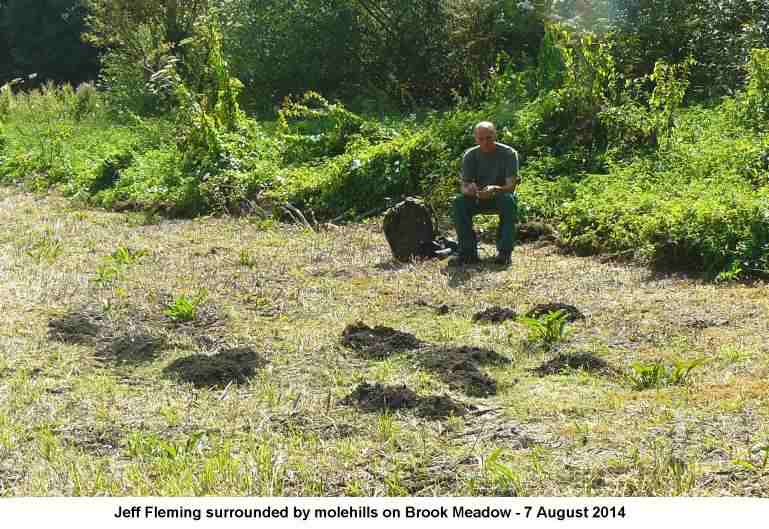
Later, I found more
fresh molehills on the cut area of the north meadow. I
do not associate molehills with summer, but rather
with the beginning of spring when the males extend
their burrows. However, burrows have another imortant
function at this time of the year, namely providing
food for the inhabitants. The burrows act as a food
trap, for invertebrate prey, such as earthworms and
insect larvae. Regarding the current activity, my
guess is that the extremely dry weather has prompted
the moles into digging new tunnels to provide more
food for their young. The same thing happens in
exceptionally cold weather when the ground
freezes.
For surveys of molehills on Brook Meadow in 2005 and
2010 see . . . http://www.brook-meadow.hampshire.org.uk/bm-moles.html
Grey
Mullett
Walking past
Peter Pond, I stopped to admire the shoals of Grey
Mullett of various sizes that were swirling around in
the shallow water near the road.
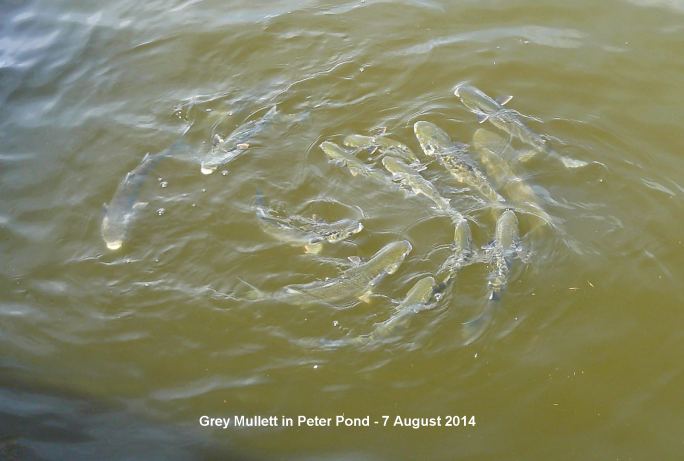
Wheatear
Malcolm
Phillips went for a walk to the marina today where he
found a rather handsome first winter Wheatear. This
bird is the start of the autumn Wheatear passage which
will carry on until October.
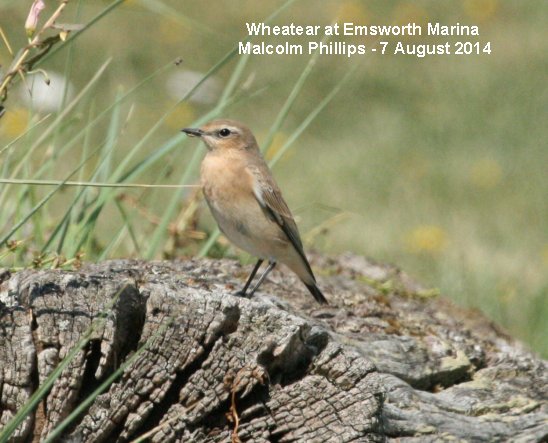
TUESDAY
AUGUST 5 - 2014
Greater
Burdock
I was pleased
to see that the rare Greater Burdock (Articium lappa)
on the verge by the pony field had been spared by the
council cutters when they strimmed the edges of the
wayside path from the end of Washington Road to
Emsworth Recreation Ground. I could not see any sign
of flowers on the Greater Burdock plants. Maybe they
had been and gone?
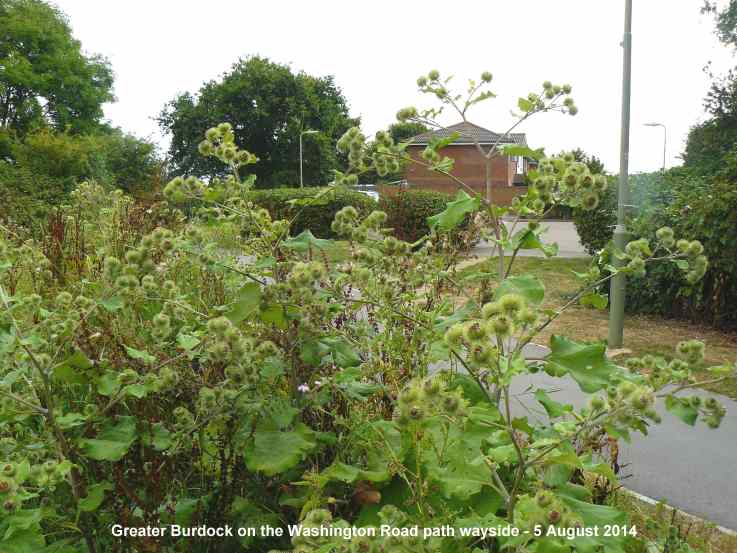
Narrow-leaved
Water-plantain
This morning I
discovered another two plants of Narrow-leaved
Water-plantain (Alisma lanceolata) in
the northern section of the Westbrook Stream towards
Victoria Road, making three in total. This is good
news as I thought they had all perished in the winter
floods. There are none in the stream adjacent to the
Bridge Road Wayside, but hopefully seeds from these
surviving plants will spread downstream to produce new
plants next year.
Clouded
Yellow
I had a quick
look at the Railway Wayside north of Emsworth Railway
Station which is a blaze of colour, yellow, red,
white, blue and pink. I found Clouded Yellow
fluttering around the plants. This insect looked a bit
battered, so maybe it was the same one I saw a few
weeks ago on July 21. It was constantly on the move
and kept hiding away in the tangled vegetation. This
was the best shot I could get of it.
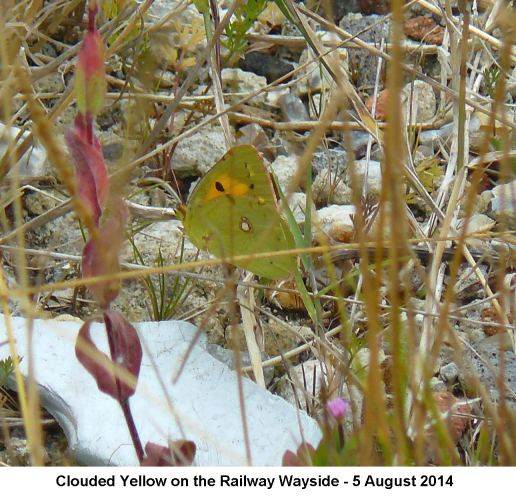
Fighting
bees?
While on Brook
Meadow this morning Malcolm Phillips saw what he
thought were bees fighting among themselves. I think
Malcolm's bees were, in fact, Drone Flies
(Eristalis tenax) - so-called for
their close resemblance to honey bee drones. They are
nectar feeders, so there would seem no obvious reason
why they should be fighting. My guess is that they
were mating, or indulging in some pre-copulation
ritual.
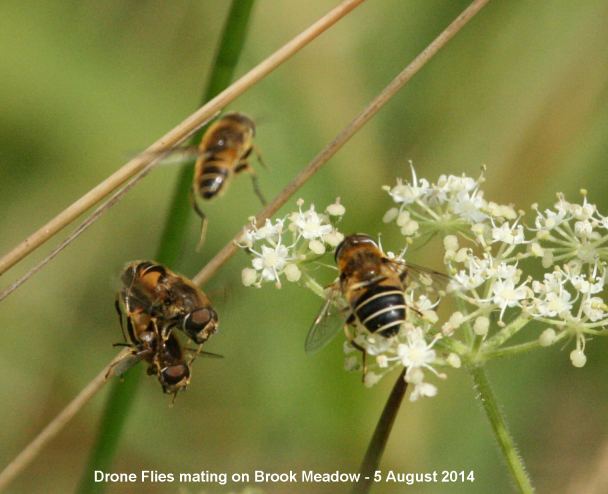
Water
Voles at Havant
Water Voles
are still flourishing in the Langbrook Stream in
Havant. On Sunday Aug 3, Ralph Hollins saw a plump
Water Vole swimming along the channel of the Mill Pond
which runs north below the white wavy metal fencing.
Shortly after the Vole climbed out of the water and
vanished into a proper tunnel, giving Ralph the
impression that one or more Voles have taken up
permanent residence in this pond where they have been
seen since Jan 23 this year and in previous
years.
Little
Egret roost at Langstone
The Little
Egret night roost at Langstone Mill Pond is building
up. On Saturday Aug 2, Ralph Hollins counted a total
of 132 compared to 85 on June 18 and 95 on July
16.
MONDAY
AUGUST 4 - 2014
Brook
Meadow
I had a late
afternoon walk through the meadow. Four Carrion
Crows were foraging around on the newly cut north
meadow, clearly finding plenty of good stuff there.
Although many animals and insects are killed by the
cutting, other wildlife benefits.
I had a mooch around in the orchid area which was a
mass of flowering Common Fleabane. The Hemp
Agrimony has also done well this year with several
clumps in flower.
I was pleased to see a good number of flowering plants
of Square-stalked St John's-wort which I find
every year only in this area. Hoary Ragwort is not
quite in flower; it is always one of the latest to
open up. The red flower heads of Great Burnet are
still standing.
Over to the Lumley area which also was dominated by
the yellow flowers of Common Fleabane. The red
spikelets of Sharp-flowered Rush are still showing
well. I found some Pepper-saxifrage flowers
open on the east side of the Lumley area.
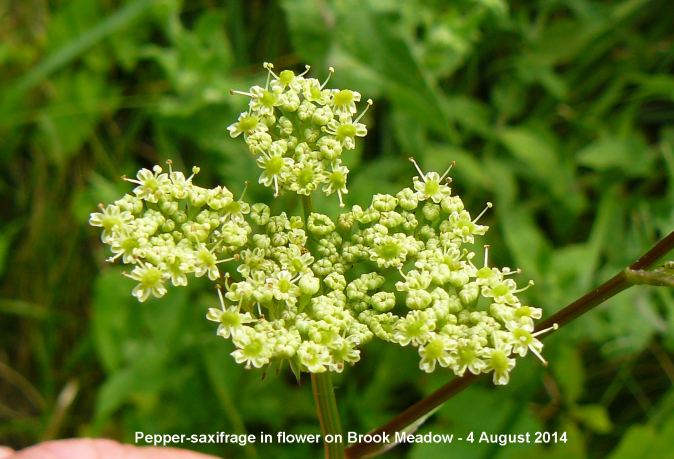
I came across a bright
Comma butterfly, which could have been one of
the hutchinsoni variety which come out
in the midsummer emergence.
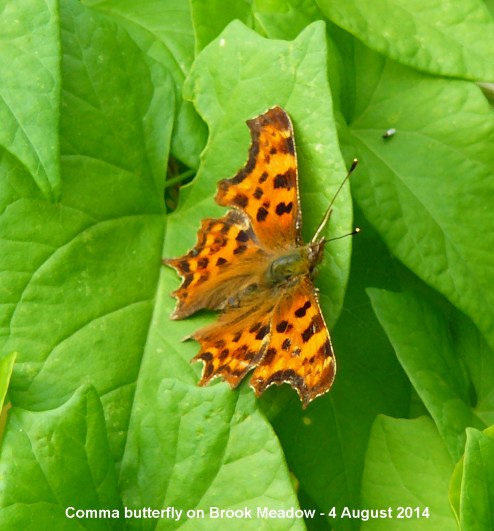
I spotted a tiny
micro-moth on vegetation near the Lumley area. I have
seen this one several times over the years, not just
on Brook Meadow. I am fairly sure it is called
Pyraustra aurata. Malcolm
Phillips got one earlier this year on 9 June.
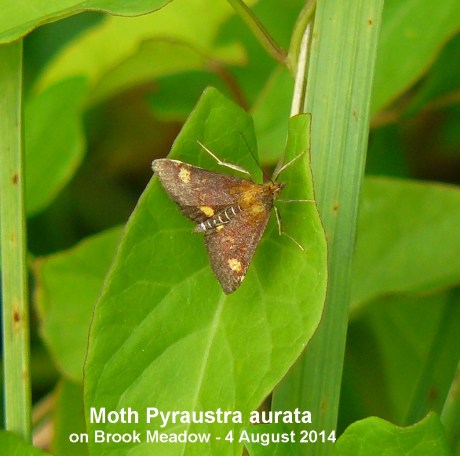
Water
Vole
Malcolm
Phillips saw a Water Vole swim across the river by the
south bridge, but could not get a photo. People keep
asking me how the Water Voles are doing and I have to
say not too good following the severe flooding of the
river last winter. Malcolm's sighting was number 48
for 2014, which is lower than any year since 2007 when
we had not really got our act together on the Water
Vole recording lark. Worryingly, nearly all recent
sightings have been from the south bridge which
suggests the same vole(s) is being seen over and over
again.
Millpond
News
Earlier today,
while passing the town millpond I noticed that the
Mute Swan pair still had their single cygnet, which
though very tiny, looked healthy enough.
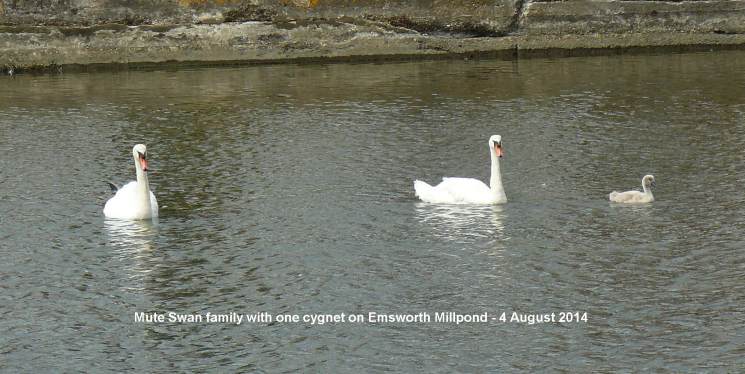
Hampshire
Farm
Chris Oakley
had another first for Hampshire Farm today, namely a
Sand Wasp (Ammophila sabulosa). Chris
says the waist is not easily seen in this photo but
others show it more clearly, although they are not so
sharp. Frankly, I have never heard of this one, though
it is covered in Chinery's book where it says it nests
in sandy places well-stocked with hairy caterpillars.
There is an illustration in my copy of Chinery of a
Sand Wasp dragging a huge caterpillar to its burrow!
Bryan Pinchen tells me the Sand wasp Ammophila is
actually an Ichneumon wasp.
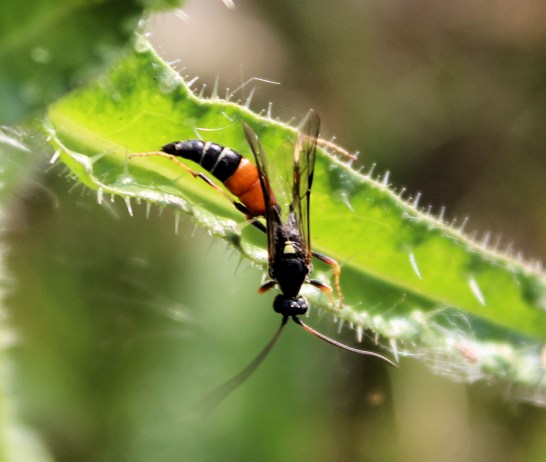
SUNDAY
AUGUST 3 - 2014
Autumn
song of Robin
I heard the
first autumn song of a Robin from my garden at about
8am this morning. The song is thin and wistful,
nothing like the cheery, bold and confident spring
song that comes later. This is quite early. Last year
I heard the first autumn song on Sept 3rd and in 2012
it was just one day earlier on Sept 2nd.
Brook
Meadow work session
This morning's
work session attracted 17 volunteers who gathered at
the new tool store on the Seagull Lane patch for the
first time. This will now be the new venue for future
workdays. Jennifer Rye briefed the volunteers on the
main tasks which included clearing overhanging bramble
spurs from the paths through the south meadow and
clearing up the large amount of litter that had
accumulated in the north-east corner of Palmer's Road
Copse where
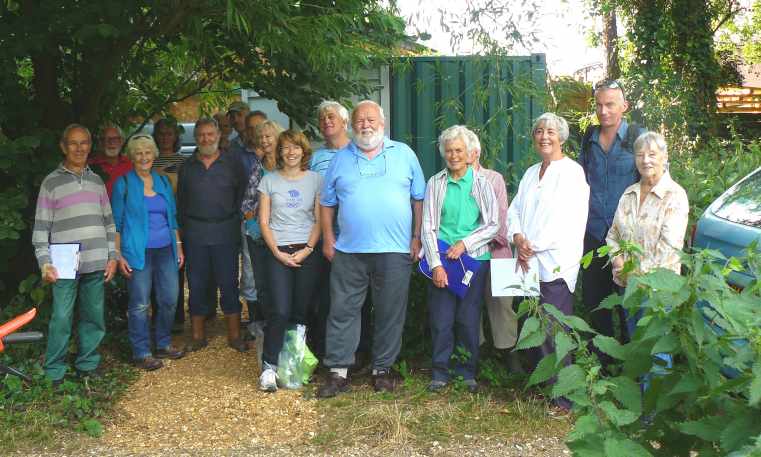
Willow
leaf galls
The leaves on
one of the Crack Willows close to the new tool store
were infested with tiny red bean galls. I think these
could be the larvae of the sawfly Pontania
proxima, though apparently there are many
similar species whose larvae live in galls on willows.
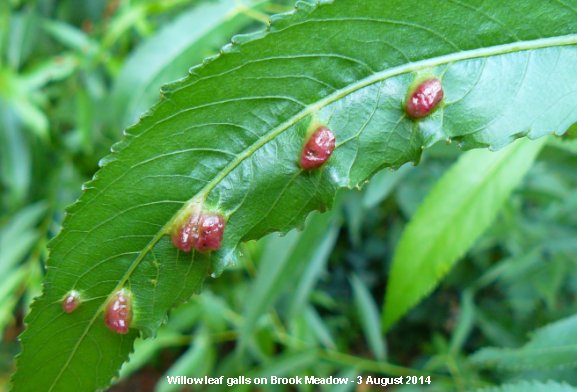
First
Clouded Yellow
Following his
discovery of the first Painted Lady of the year on
Brook Meadow on 31 July, Malcolm Phillips went one
step better today with the first Clouded Yellow of the
year. How patience with the camera pays off.
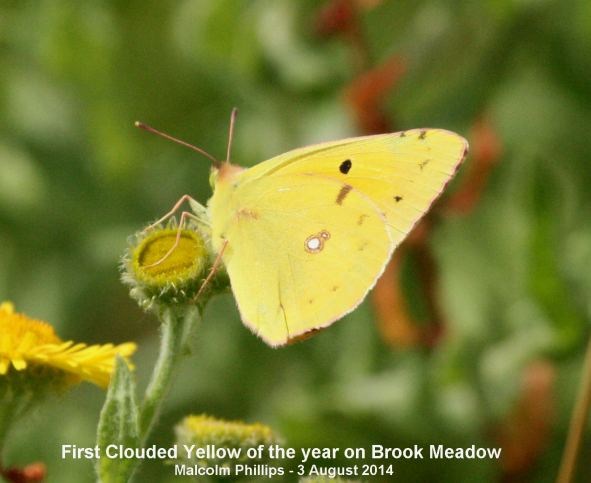
Mute
Swan news
Kim Robinson
was delighted to come back from a camping holiday in
Wales to see all four swan cygnets, just over 6 weeks
old, looking great on the Deckhouses Estate pond. That
is a very good habitat for them.
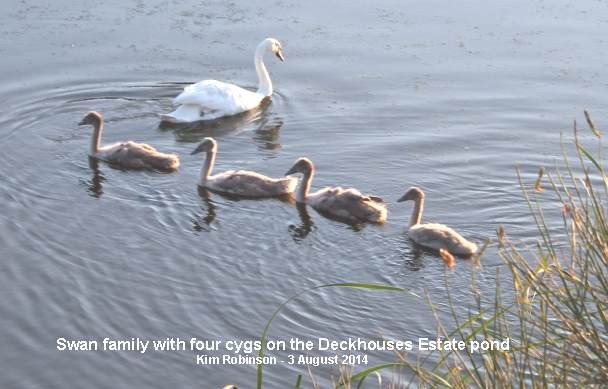
Warblington
shore
Peter
Milinets-Raby said it was a chilly 12C this morning at
7am and with the brisk wind it felt like autumn. He
walked along the Warblington shore via the Sweet Corn
fields at the back of Conigar Point (7:05am to
9:21am). Main sightings:
Ibis Field Hedge: 35+ Goldfinch feeding in the wild
flower patch of the cemetery extension, 3 Whitethroat,
2 Blackcap (male and a juv female), 2+ Chiffchaff,
Stock Dove.
Hedgerow behind Conigar Point: 4 Chiffchaff, 2 Willow
Warbler (see photo), Reed Warbler in the hedge, 3
Long-tailed Tits, Lesser Whitethroat.
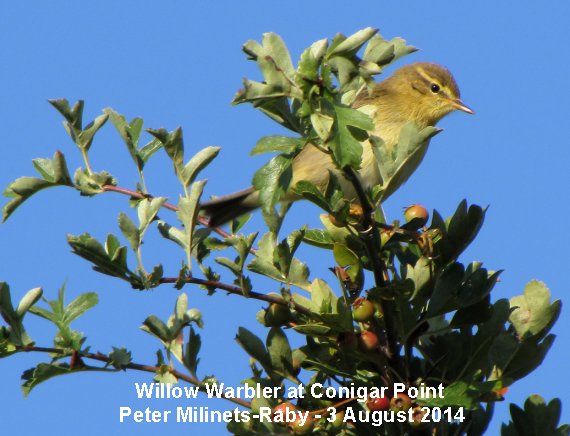
Conigar Point: 5 juv
Shelduck, 1 Black-tailed Godwit (winter), 4 Grey
Plover, 2 Whimbrel, 1 Greenshank G - R/BBtag -, 4
Dunlin, 4 Little Tern, 6 Common Tern, 4 Little
Egret.
Pook Lane: 7 Greenshank G - R/GO - and RG - /YYtag -
13 Grey Plover, 28 Dunlin, 1 partial summer plumaged
Knot.
Two
Spotted Redshank
From my point
of view, Peter's most exciting sighting was two
Spotted Redshank at Conigar Point. They included the
colour-ringed bird W+GR that he first saw there
on July 31st. It still had some remnants of summer
plumage on lower belly and under tail. The other bird
was feeding next to it and was in winter plumage.
Peter thought it looked like the 'pale bird' that has
been frequenting Nore Barn for the last 10 winters.
However, I doubt it as the Nore Barn bird is always
late arriving. Its earliest arrival ever at Nore Barn
ever was on 9th October in 2012. Quite a few Spotted
Redshanks will be passing through this country at this
time of the year on passage to wintering quarters in
Tropical Africa. These will be females that have left
the males on the breeding grounds to look after the
nest and the chicks. Males follow later. I think the
Nore Barn bird is a male.
Hampshire
Farm
Chris Oakley
says Hampshire Farm meadow was looking more like the
pampas this afternoon with the golden grass rippling
in the wind. He found a Meadow Grasshopper - the only
British grasshopper that is flightless. The bulk of
the dragonflies and damsels have moved on but Chris
did see three Emperors away from the pond hawking over
the grass. The Common Blue butterflies are looking
very battered now, some with badly shredded wings.
This female was still looking very smart
though.
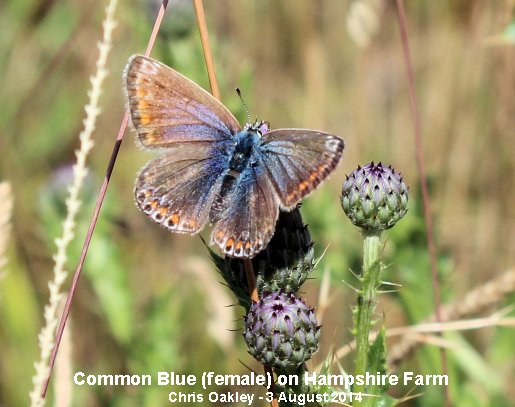
Chris says, some of
the bushes are beginning to show fruit at last. The
Blackthorn is heavy with sloes and Hazel has a good
crop of nuts. The local Blackberries are very small
and are showing signs of drop. The same with the
Spindle berries which are just drying up but the
Hawthorn is heavy with fruit. Chris feels there will
be mixed fortunes this autumn.
FRIDAY
AUGUST 1 - 2014
Brook
Meadow
Malcolm
Phillips went round the meadow for an hour this
morning. He spent most of it on the south bridge where
he saw a good selection of the common resident birds.
He also spotted what was clearly a Brown Rat on the
river bank (not a Water Vole).
He went back in the afternoon, Martin Cull was busy
cutting the north meadow where Swallows were
swooping low and taking food to youngsters in the
old dead tree on the east side of the meadow. That is
the first record I have of young Swallows on Brook
Meadow.
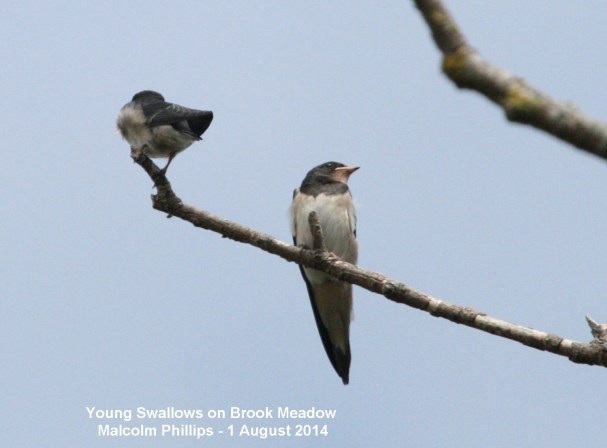
Malcolm also got a
great shot of a Blackbird feeding on the Rowan
berries. So, that is where they all disappear to
before the winter comes.
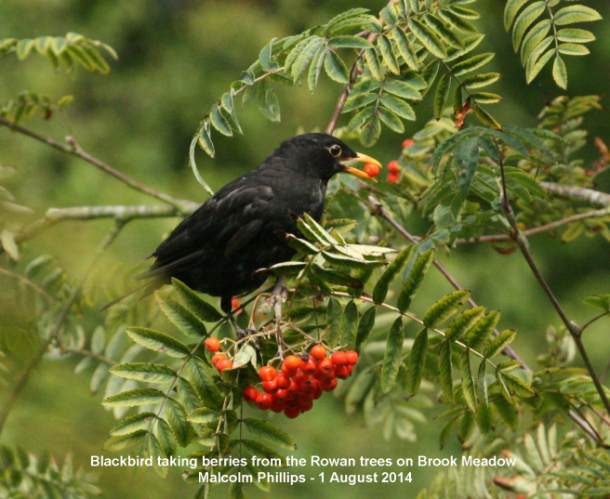
Warblington
shore
Peter
Milinets-Raby took his regular walk along to the
Warblington shore as the tide pushed in this afternoon
(12:14pm to 1:44pm).
Conigar Point: 5 Greenshank (two coloured ringed G -
R/BRtag - and G - R/BBtag - These five birds flew off
towards Thorney Island. 1 Black-tailed Godwit winter,
14 Dunlin, 1 Ringed Plover (unusual record), 1 summer
plumaged Knot (first returning bird feeding with
Dunlin), 6 Lapwing, Shelduck juv., 2 adult Mute Swan,
1 Sandwich Tern. Chiffchaff heard calling from
Tamarisk Hedge.
Pook Lane; 11 Greenshank (together on a sea marsh
tussock resting as the tide pushed in. 3 with rings RG
- /YYtag - and G - R/GO - and G - R/YN - ), 6 Grey
Plover, 16 Dunlin, 2 Common Tern, 4 Lapwing, 184+
Redshank, Sand Martin,
No sign of yesterdays Spotted Redshank.
Spotted
Redshank W+GR
Concerning the
colour-ringed Spotted Redshank that Peter saw
yesterday, Anne de Potier agreed that was indeed
excellent news. And even more so as it was such an
early sighting. This suggests the bird is a female
that left the breeding grounds early, either because
the clutch failed or maybe just to get away leaving
the male to look after the eggs and chicks. Anne saw
that bird 3 times in April, but does not know whether
anyone else saw it since January.
Barn
Owl found
Gez Watson
wrote to say the Barn Owl that was reported missing
was found in their garden by an elderly couple living
at the northern edge of Emsworth.
For
earlier observations go to . . July
17-31